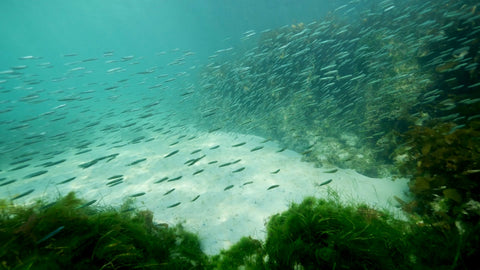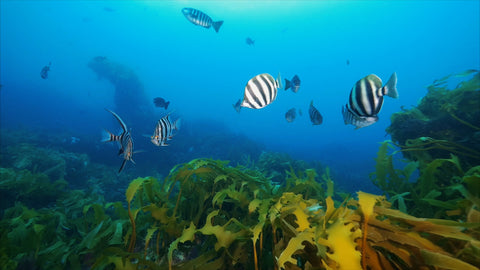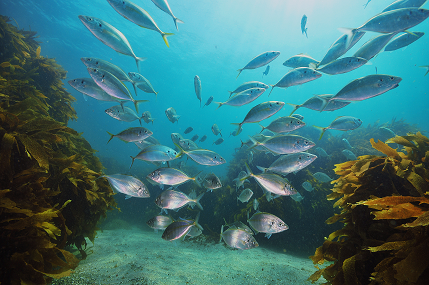In 2022, Dr Chris Gillies had an ‘aha’ moment.
Unlike Newton, it didn’t involve an apple falling from a tree, nor did he run naked through the streets like Archimedes. Instead, he was halfway through a fish taco when he realised that seafood sustainability could be achieved by following a very simple principle: One Fish, Two Fish.
1F2F talks to Seafood Positive's founder, Dr Chris Gillies, about starting OneFishTwoFish and seafood sustainability.What is the principle behind OneFishTwoFish?
CG - It’s pretty simple! We’re working with some amazing organisations to put two fish back into the ocean for every one fish that is taken out. Think about that over time! You end up with an ocean teeming with life, like it was a hundred years ago. So we partner with various restaurants, vendors and fishing companies... and for every one fish they sell, we seek to put two back.

All of this over a fish taco?
CG - (laughs) I was halfway through, and I was thinking about carbon offsetting. So I googled ‘seafood offsetting’, and nothing came up. Nothing. I couldn’t believe it.
So, it is a world first in seafood offsetting?
CG - I suppose so. I don’t really think in those grandiose terms, but I’ve not come across anything similar. And for a while, that bothered me. I kept thinking to myself, ‘If I or any of my friends wanted to give back and contribute to seafood sustainability, we have no options!’ So, we built that option. Hopefully it helps remove the ethical dilemma so many people feel when buying or consuming seafood.
And what is that dilemma?
CG - Well, do you enjoy seafood, or help protect the oceans? Everyone has felt the tension at some point. But now, if you subscribe to OneFishTwoFish or buy from one of our partners, you can give a little back to oceans and feel more comfortable that the seafood you are eating is more sustainable. You can eat seafood, and help save the ocean at the same time. It’s a win-win.
How does this affect the everyday person?
CG - It means you can feel more positive in the way you buy seafood. Sometimes it’s hard to know if something is really sustainable, but with OneFishTwoFish you at least know that you're helping people put fish back into the ocean. Your purchase is not only neutral, it’s Seafood Positive!
It sounds simple, but there must be quite a bit of complexity in actually making this happen.
CG - Of course. Understanding how fisheries work is really complicated.
There is a lot of maths and statistics involved and it’s not straightforward.
My PhD is in food web ecology, and I’ve spent decades thinking and working with scientists all over the world about how whole ecosystems work; how you rebuild them, how you protect them… I’ve spent a lot of time underwater, including in Antarctica, around Australia and on remote tropical atolls.
In all these places, nature essentially follows the same rules. Every fish is in a battle for survival. From starvation, competition and predators, including humans.
But we know that when the places they live are left intact or are restored, they have a much better chance of surviving and thriving. So yeah, it is complex but nature follows some simple rules that we can apply when thinking about sustainability and fisheries management.

How do you see OneFishTwoFish fitting in with other sustainability initiatives?
CG - Well, existing programs are mostly focused on how fishers can take less fish from the ocean in the least harmful way. That’s absolutely crucial and is the first step in sustainability.
OneFishTwoFish is unique from all the others, because it has a focus on replenishing the ocean, not just reducing the intake. And that is important because as human populations are increasing, we need to feed more people, not fewer people.
Nature rarely bounces back quickly unless we give her a helping hand. So, we have got to reverse the losses we’ve suffered over hundreds of years, and need to get more fish back in the ocean.
That’s a huge step forward for making our fisheries more sustainable. When OneFishTwoFish works in partnership with other programmes, that is where we get sustainability right throughout the supply chain.
On that note, the narrative around fisheries has been quite negative for a long time. Is there a point where it just becomes impossible?
CG - Yeah, I could go on and on about the issues we are facing globally; the loss of fish, the increase in microplastics, climate change, et cetera. But you’re right, we’ve heard that before.
We probably even put it in the ‘too hard’ basket because we rarely hear about the good news stories, the successes … But I’m also aware that seafood can be sustainable. It can be the most sustainable source of animal protein in the world, if we get it right. There is good news out there. There is hope.
So, what are you aiming to achieve?
CG - Well ultimately, we want the seafood industry to be neutral. In the next five years, we want to see 20% of Australia’s seafood being offset. That would be about $30 million going towards habitat restoration projects around Australia. And from there, we want to see this spreading globally… Imagine that world, one that doesn’t have a limited supply chain of fresh fish. We harvest them, eat them, and put more back.
Is that utopia possible?
CG - Absolutely! That tomorrow is a real possibility. It all just hangs on what we do today.


